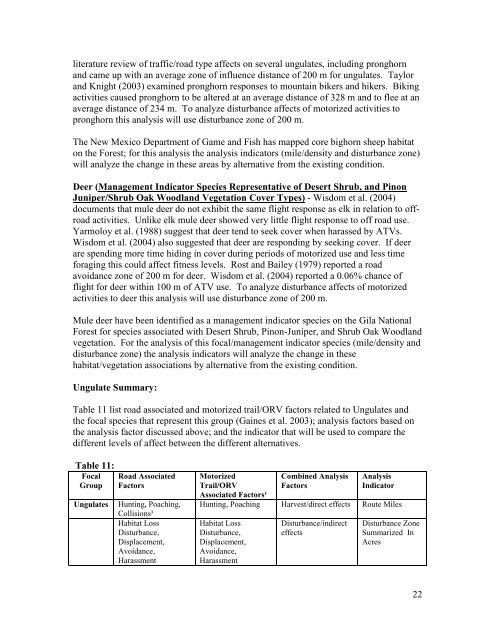Wildlife Specialist report
Wildlife Specialist report
Wildlife Specialist report
You also want an ePaper? Increase the reach of your titles
YUMPU automatically turns print PDFs into web optimized ePapers that Google loves.
literature review of traffic/road type affects on several ungulates, including pronghorn<br />
and came up with an average zone of influence distance of 200 m for ungulates. Taylor<br />
and Knight (2003) examined pronghorn responses to mountain bikers and hikers. Biking<br />
activities caused pronghorn to be altered at an average distance of 328 m and to flee at an<br />
average distance of 234 m. To analyze disturbance affects of motorized activities to<br />
pronghorn this analysis will use disturbance zone of 200 m.<br />
The New Mexico Department of Game and Fish has mapped core bighorn sheep habitat<br />
on the Forest; for this analysis the analysis indicators (mile/density and disturbance zone)<br />
will analyze the change in these areas by alternative from the existing condition.<br />
Deer (Management Indicator Species Representative of Desert Shrub, and Pinon<br />
Juniper/Shrub Oak Woodland Vegetation Cover Types) - Wisdom et al. (2004)<br />
documents that mule deer do not exhibit the same flight response as elk in relation to offroad<br />
activities. Unlike elk mule deer showed very little flight response to off road use.<br />
Yarmoloy et al. (1988) suggest that deer tend to seek cover when harassed by ATVs.<br />
Wisdom et al. (2004) also suggested that deer are responding by seeking cover. If deer<br />
are spending more time hiding in cover during periods of motorized use and less time<br />
foraging this could affect fitness levels. Rost and Bailey (1979) <strong>report</strong>ed a road<br />
avoidance zone of 200 m for deer. Wisdom et al. (2004) <strong>report</strong>ed a 0.06% chance of<br />
flight for deer within 100 m of ATV use. To analyze disturbance affects of motorized<br />
activities to deer this analysis will use disturbance zone of 200 m.<br />
Mule deer have been identified as a management indicator species on the Gila National<br />
Forest for species associated with Desert Shrub, Pinon-Juniper, and Shrub Oak Woodland<br />
vegetation. For the analysis of this focal/management indicator species (mile/density and<br />
disturbance zone) the analysis indicators will analyze the change in these<br />
habitat/vegetation associations by alternative from the existing condition.<br />
Ungulate Summary:<br />
Table 11 list road associated and motorized trail/ORV factors related to Ungulates and<br />
the focal species that represent this group (Gaines et al. 2003); analysis factors based on<br />
the analysis factor discussed above; and the indicator that will be used to compare the<br />
different levels of affect between the different alternatives.<br />
Table 11:<br />
Focal<br />
Group<br />
Road Associated<br />
Factors<br />
Ungulates Hunting, Poaching,<br />
Collisions³<br />
Habitat Loss<br />
Disturbance,<br />
Displacement,<br />
Avoidance,<br />
Harassment<br />
Motorized<br />
Trail/ORV<br />
Associated Factors¹<br />
Combined Analysis<br />
Factors<br />
Analysis<br />
Indicator<br />
Hunting, Poaching Harvest/direct effects Route Miles<br />
Habitat Loss<br />
Disturbance,<br />
Displacement,<br />
Avoidance,<br />
Harassment<br />
Disturbance/indirect<br />
effects<br />
Disturbance Zone<br />
Summarized In<br />
Acres<br />
22
















